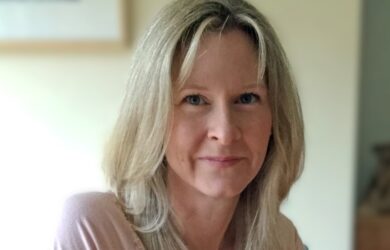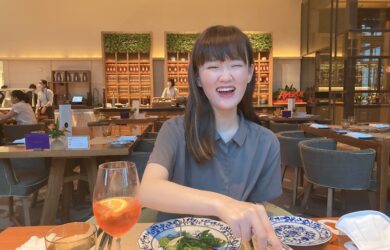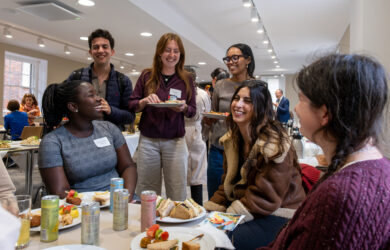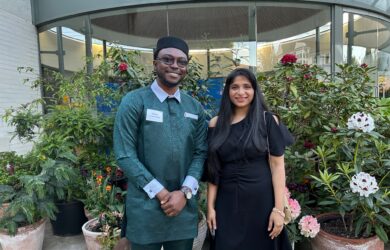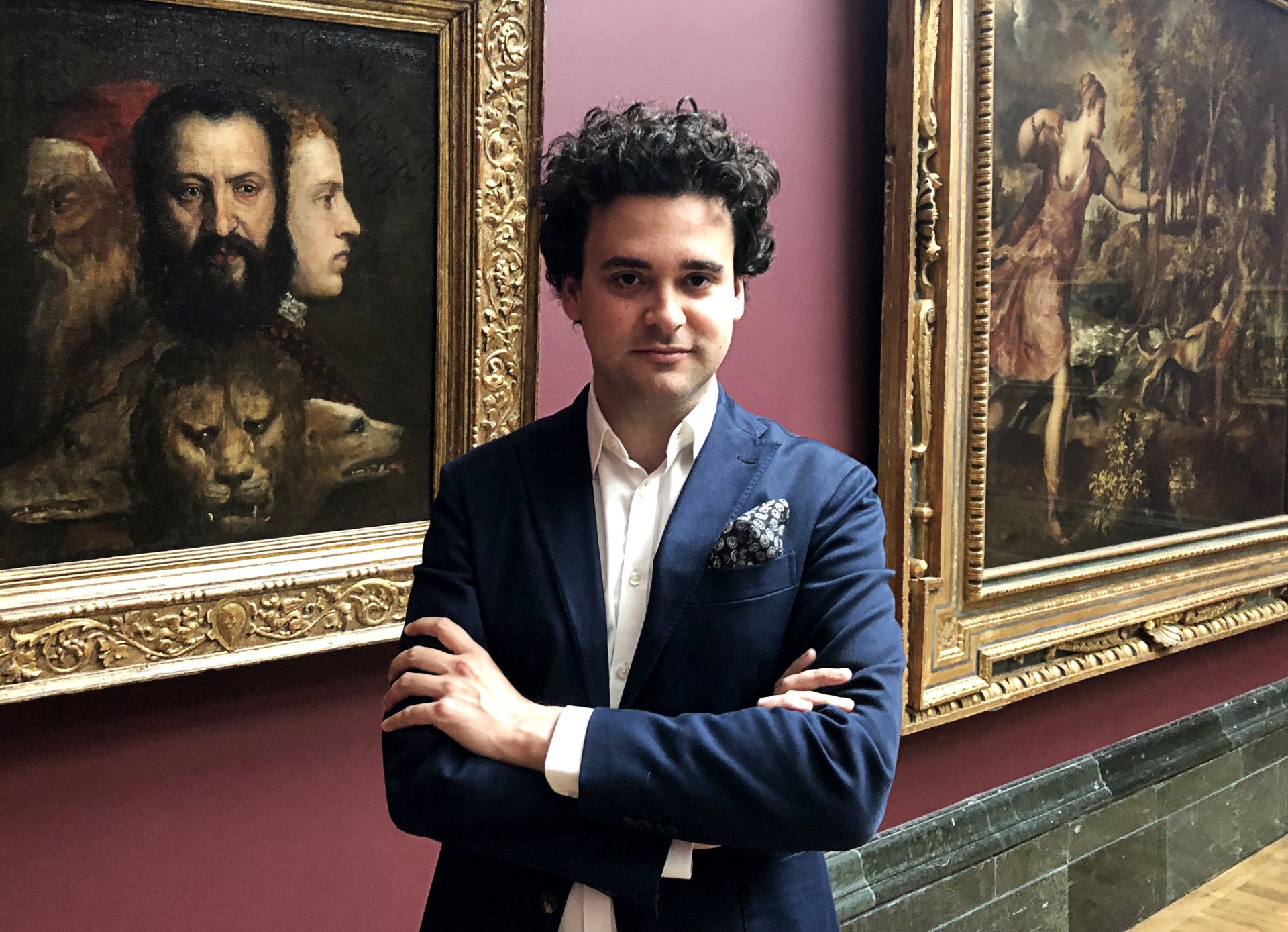
Julien Domercq talks about his career as an international art curator and his recent move to the Royal Academy of Arts
Museums do not always think outside the box. Cambridge and Gates Cambridge informed the kind of creative I am. It made me think in a multidisciplinary way, beyond the realm of pure art history.
Julien Domercq
Even while he was doing his PhD in art history, Julien Domercq was not only getting involved in the British art scene, he was curating one of the biggest art exhibitions of the day.
Julien [2013] had taken up a two-year entry-level contract at the National Gallery a couple of years into his PhD on the shift in depictions of the peoples of the Pacific in British and French art from idealisation to demonisation between the Enlightenment and the Age of Empire.
He says: “One morning in our shared office overlooking Trafalgar Square, Christopher Riopelle, the Curator of Post-1800 Paintings at the Gallery, turned towards me and said, casually: ‘Would you like to curate an exhibition on Degas?’ ‘Let me think. Yes!’ came my reply.
The show, “Drawn in colour: Degas from the Burrell”, which opened around the anniversary of Degas’ death in 2017 and closed in 2018, was very well received critically and was the most visited exhibition at the National Gallery, attracting around 400,000 people. Julien was really pleased that many people were repeat visitors as he says that shows you something about the experience they had.
“What I am interested in is whether we are providing visitors with a worthwhile experience and it was heartening with Degas that, aside from the numbers of visitors, when you listened to what they were saying you got a sense of how they were approaching the show and that they were really enjoying the works,” he says.
That comes down in large part to how the show was curated. It consisted of around 30 works shown in three different themed spaces. Julien adds: “The works were on paper so they were fragile and required low light levels. We wanted to make a virtue of that and build an ambience, to make them shine like jewels and to create an atmosphere. It worked and people found a way to commune with the works. I saw people standing and genuinely spending time with the works which is important in a world where we are so used to consuming images quickly and going next, next, next.”
Of course, the fact that Degas is so well loved helped, but Julien adds that he is also much misunderstood. “Some people think of him as a chocolate box kind of artist,” he says. “The show was trying to go against that and to present a new perspective of him as an experimental artist, someone in the avant garde, relentlessly pushing forward the boundaries. A lot of successful artists get to a plateau and coast, but others, like Degas, keep innovating – to the point that, at the end of his life, he drove himself into a dark place where he was constantly dissatisfied with his work and always hoping to move beyond what he did last.
“And he did that very much taking up the act of painting itself as his main subject, producing works, always rooted in realism, but that tended towards abstraction, where what they were really about was colour, form, line. That’s why people and a lot of artists still respond to his work today, find that his art really speaks to them, more than a century later. He’s very much a painters’ painter.”
In the US
The show ran for six months and Julien soon got another job, managing to fit in a bit more academic research when he spent a month at Yale in early 2019 on a fellowship at the Centre for British Art. From there he moved to the Dallas Museum of Art where he was appointed assistant curator for European art covering the period from the Renaissance to the late 18th century. It was a very different institution from the National Gallery.
It had to build its collection of European old masters and had a solid acquisition budget to do so whereas the Gallery is a more established institution with a much more fully formed collection. That presented a different type of challenge for Julien – how do you build an Old Masters collection in the 21st century? He says his time in Dallas taught him a lot about how US museums work, which was invaluable given the UK model is becoming more similar to the US one, in terms of reliance on fundraising.
Covid
When Covid erupted, Julien was in Europe at the TEFAF art fair in Maastricht. Julien caught Covid at the event and found himself stranded in London after the US borders were closed by the Trump administration. He worked remotely for the Dallas museum for several months. It forced him to think about what museums are for and what can be done when they cannot be accessed and the relationship between real objects and people is lost. The museum pivoted to online events.
“It was a real paradigm shift from working in the office and feeling close to the objects and very rooted,” says Julien. “There are so many digital images online, but our uniqueness as museums is to connect people to real works of art. Standing in front of the real thing [as opposed to a virtual work] can be life-changing, but we had to ensure people’s interest in art was maintained until we could reopen. It showed me that we have to be quite careful about how we use the online space.”
He says technology can, however, allow museums to reach a much wider audience. “It’s about trying to find the right balance,” he says. “I think a key aspect of the work of the curator in the 21st century is to fully embrace the amazing potential of technology to make art more accessible than ever before, while reminding people that works of art are real things and beating the drum for the kind of otherworldly and life-enhancing interaction between people and works of art which can only really happen in a museum.”
When the museum reopened Julien had to install an exhibition via Zoom, which he says took all the joy out of his job. There came a point when he could apply for one-way travel back to the US. It forced him to think deeply about what he was doing. His job was based on the promise of international travel and shows and on high-level acquisitions around the world. He realised too that he felt “profoundly European” and that he wanted to remain in London.
After Impressionism
He parted ways amicably with the Dallas museum in November 2020 and spent some time in the French countryside, thinking about his future. He knew it was risky to leave a permanent job at that time, but felt it was the right thing for him and, serendipitously, he soon received a call from Christopher Riopelle at the National Gallery. “He asked me what I was doing for the next two years,” says Julien. He was invited to co-curate the After Impressionism: Inventing Modern Art show, which had been delayed due to Covid and was affected by the resulting uncertainty which made other museums reluctant to loan art works.
The After Impressionism exhibition was due to be the National Gallery’s largest show with 100 works, and tell the story of what happened to European art following the last Impressionist exhibition of 1886 and the beginning of the First World War. A handful of works had been pledged, but there were a lot more to gather. The show was the brainchild of curator and art historian MaryAnne Stevens who wanted to bring together works by iconic French artists such as Rodin, Van Gogh, Gauguin, Cezanne and Matisse, but also by lesser known artists who operated in one of the four emerging centres of the avant garde in the early 20th century – Barcelona, Brussels, Vienna and Berlin.
The big challenge was how to secure artworks. The National Gallery focused on building partnerships with other museums, including Russia’s Pushkin Museum, but the Ukraine invasion in early 2022 sent them back to the drawing board. So, with one year to get the artworks together for the exhibition, Julien and MaryAnne travelled around the world visiting private collections and museums. “It was the perfect antidote to Covid,” says Julien, adding: “There was a feeling of solidarity. It was both extremely stressful, but also incredibly rewarding to see so many people coming to our rescue.”
The exhibition was the biggest in the National Gallery’s history and was another critical success for Julien. “In the end most visitors had no idea of the magnitude of the work that went into it. We were forced to be creative and think outside the box. In the end, a third of the works came from private collections. We had five Van Goghs and four were from private collections. Most people had never seen them before. We had a great Cubist portrait by Picasso from one of the finest private collections in the US that hadn’t been seen in Europe in over 50 years.”
Van Gogh
The exhibition opened in March 2023 and closed in Mid-August. Julien then moved on to another show on Van Gogh which will open in time for the National Gallery’s bicentenary in September 2024. The gallery has been able to borrow a great number of Van Gogh’s finest works and Julien says the show has a really strong narrative thread. “It shows Van Gogh as very reflective. He was the most well read artist of the 19th century. Almost all his letters reference literature,” says Julien. “We will show him as an artist of imagination. We are taking an innovative approach. Some of the works have not been seen before and we have brought them together. It will be a very special exhibition.”
Gates Cambridge
Julien says he owes a lot of his success to his time at Cambridge. The international and collaborative atmosphere and the emphasis on thinking outside the box have been important ingredients to his approach to curation. “Museums do not always think outside the box,” he says. “Cambridge and Gates Cambridge informed the kind of creative I am. It made me think in a multidisciplinary way, beyond the realm of pure art history.”
He adds that Gates Cambridge’s emphasis on public service also had a big influence on him. “I was surrounded by people doing life-changing things for others. It made me think what my role could be as an art historian, curating shows and opening people’s eyes to new ideas through works of art, empowering them to enjoy works of art, and perhaps even getting to find themselves just a little bit more in the process.”
Julien has recently moved to the Royal Academy of Arts where he is curator responsible for 18th and 19th century and Old Masters exhibitions. “I’m now in a position to build an exhibition programme over a longer period of time and actively shape the story I want to tell,” he says. He loves the fact that the RA is an art school as well as an exhibition space. He says: “Art is made in the building. That’s very important to me. It makes things vibrate just that little bit more and gives them a new resonance.”








